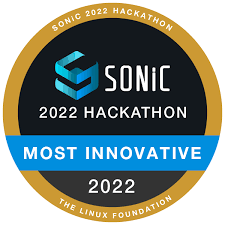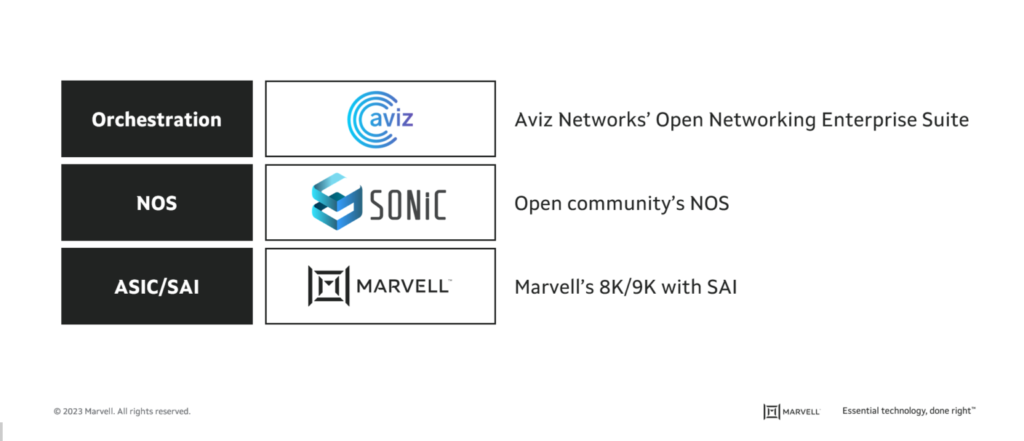- PRODUCTS
- COMPANY
- SUPPORT
- PRODUCTS
- BY TYPE
- BY MARKET
- COMPANY
Our Company
Media
Contact
- SUPPORT
Marvell and Aviz Networks Collaborate to Drive SONiC Deployment in Cloud and Enterprise Data Centers
Disaggregation is the future
Disaggregation—the decoupling of hardware and software—is arguably the future of networking. Disaggregation lets customers select best-of-breed hardware and software, enabling rapid innovation by separating the hardware and software development paths.
Disaggregation started with server virtualization and is being adapted to storage and networking technology. In networking, disaggregation promises that any networking operating system (NOS) can be integrated with any switch silicon. Open source-standards like ONIE allow a networking switch to load and install any NOS during the boot process.
SONiC: the Linux of networking OS
Software for Open Networking in Cloud (SONiC) has been gaining momentum as the preferred open-source cloud-scale network operating system (NOS).
In fact, Gartner predicts that by 2025, 40% of organizations that operate large data center networks (greater than 200 switches) will run SONiC in a production environment.[i] According to Gartner, due to readily expanding customer interest and a commercial ecosystem, there is a strong possibility SONiC will become analogous to Linux for networking operating systems in next three to six years.
As a community-driven NOS with a silicon-agnostic open standards-based Switch Abstraction Interface (SAI), SONiC has indeed leveled the NOS playing field. The SAI allows for the rapid introduction of new switch silicon, providing a choice of open, disaggregated networking hardware to the NOS—just as Linux did for server infrastructure.
It’s no surprise, then, that in April 2022, the Linux Foundation announced that SONiC is part of the Linux Foundation family of open networking projects. The transition of SONiC development to the Linux Foundation will accelerate new feature development and drive greater scale, participation, and usage from the vibrant open-source community. The Linux Foundation will focus on the software aspects of SONiC and continue to partner with OCP (Open Compute Project) for hardware and SAI specifications.
Marvell’s SAI/SONiC commitment
While SONiC NOS itself is based on SAI, proprietary NOS’ are adopting SAI, as well. Marvell offers a feature-rich SAI across its data center switch portfolio, working with cloud customers to support SONiC or other cloud network operating systems on top of Marvell switch silicon. Marvell’s SONiC contributions include being the first to enable the SONiC NOS on embedded Arm processors and the development of Ethernet Bunch-Of-Flash (EBOF) solutions running partner-hardened SONiC for next-generation storage use cases.

At the ONE Summit’s SONiC hackathon in November 2022, the Marvell team won the first place award for SONiC footprint reduction under the “optimized SONiC build image size” category.
And as a premier member of the Linux Foundation, Marvell will continue to innovate in SAI/SONiC—in close collaboration with the community—to help realize the vision of a truly open-source standardized network operating system.
Marvell and Aviz Networks: a best-of-breed disaggregated offering
A concern voiced by operators considering SONiC adoption is that OEMs offering SONiC still amounts to vertical integration. As such, it doesn’t actually diversify the supply chain, the logic goes.
But this concern misses the bigger picture. Disaggregation does not end with hardware and operating system, it begins with it. A comprehensive open-source solution is built on the entire ecosystem, including support and services. In this way, a complete disaggregated solution can be assembled across hardware, software, optics, support, and services.
As an example, Marvell and Aviz Networks have collaborated to offer to cloud and enterprise data centers a SONiC-based solution using Marvell switch silicon.

Marvell delivers switch silicon with SAI to plug into open-source SONiC, while Aviz Networks provides disaggregated support and services alongside cloud-native applications. The Aviz Networks ONES (Open Networking Enterprise Suite) stack offers orchestration, telemetry, assurance, and support. Orchestation enables network administrators to compose, validate and deploy network configurations across any SONiC implementation. Assurance ensures key network metrics meet SLAs for network traffic. Telemetry provide insights about real-time network health.
Marvell and Aviz Networks have successfully deployed to production hundreds of 400G fabric switches with SONiC running on Marvell silicon in the enterprise data center. The leaf and spine switches are deployed with 100G and 400G ports and connected with active electrical cable (AEC) and DR4 optics. The customer benefits from industry innovation, their choice of optics, and broad skill-set availability. And they can easily scale the fabric, all of which results in both OPEX and CAPEX savings.
We expect the successful collaboration with Aviz Networks will extend to many more enterprise and cloud data center operators in the months and years to come as the benefits of disaggregated networking become more widely understood and embraced.
[i] https://blogs.gartner.com/andrew-lerner/2021/03/15/sonic-disruptions-in-the-data-center-network/
Tags: EBOF, Networking OS, NOS, ONES, Open Networking in Cloud, SAI, sonic, SONIC Hackathon, SONIC NOS
Recent Posts
Archives
Categories
- 5G (12)
- AI (30)
- Automotive (26)
- Cloud (16)
- Coherent DSP (10)
- Company News (103)
- Custom Silicon Solutions (7)
- Data Center (55)
- Data Processing Units (22)
- Enterprise (25)
- ESG (6)
- Ethernet Adapters and Controllers (12)
- Ethernet PHYs (4)
- Ethernet Switching (41)
- Fibre Channel (10)
- Marvell Government Solutions (2)
- Networking (36)
- Optical Modules (15)
- Security (6)
- Server Connectivity (26)
- SSD Controllers (6)
- Storage (22)
- Storage Accelerators (2)
- What Makes Marvell (40)
Copyright © 2025 Marvell, All rights reserved.
- Terms of Use
- Privacy Policy
- Contact

